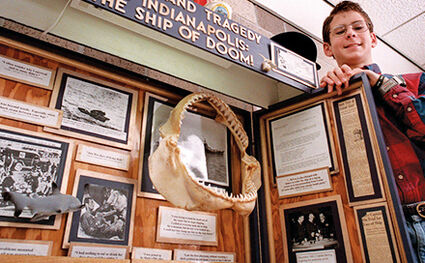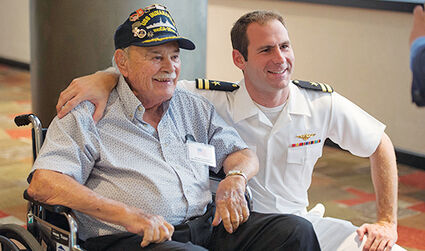SOS Indianapolis: Behind the sinking of the heavy cruiser, part 3
July 23, 2022

Photo credit: News Journal/USA Today Network.
Hunter Scott poses with the 1997 National History Day project that ultimately won redemption for McVay.
[Editor's note: This is the conclusion of the article from our July 9, 2022 issue.]
In 1990, Dan Kurzman's "Fatal Voyage" took a comprehensive look at the Indianapolis story. After reading a San Francisco Chronicle article about the book, Young reached out to Kurzman.
According to a Jan. 30, 1991, article in the Chronicle, Kurzman had several conversations with Young and concluded, "I believe that what Young says is true." Kurzman rewrote a passage in the paperback edition of his book, adding he knew of three reports from radiomen who had received Indianapolis' SOS. It marked the first published acknowledgment of anyone having received the cruiser's SOS.
That same month, Young received another request for information – this one from McVay's son, Kimo. In his response Young detailed the events of that fateful night and his suspicion Commodore Jacobson had been drinking. The officer's terse, "No reply at this time," Young felt had been a missed opportunity to quickly rescue hundreds of Indianapolis survivors.
In the 1990s, Young reached out to Capt. William J. Toti, then commander of the fast-attack submarine USS Indianapolis, to share the story of the SOS message. Toti checked out the story with the Naval Historical Center (present-day Naval History and Heritage Command), only to be told its researchers could verify neither Young's account nor the two other reports that had surfaced regarding Indianapolis' SOS. Toti offered to help Young, but by then the intrepid crusader was worn out. What Young perceived as the Navy's unwillingness to correct the record had led to a decline in his health, and on Aug. 24, 1997, he passed away at age 75. His wife, Eleanore, continued his fight.
So did a sixth-grade history buff in Pensacola, Florida.
In 1997, Hunter Scott chose the sinking of Indianapolis as the subject of his project for National History Day. The 12-year-old ultimately sent a detailed questionnaire to more than 100 survivors, scores of whom either responded by mail, spoke with the boy on the phone or met him in person. The information and documents Scott gathered convinced him McVay should be exonerated. His effort drew national media attention. Scott appeared on television several times, and on Sept. 14, 1999, he and several members of the USS Indianapolis (CA-35) Survivors Organization testified before the Senate Armed Services Committee.

The Senate Armed Services Committee hearing ultimately prompted Congress to issue a joint resolution exonerating McVay for the loss of Indianapolis.
When asked by Sen. Bob Smith of New Hampshire about reports he'd received regarding SOS messages from the cruiser, Scott replied he'd gotten three. Russell Hetz, who as a young sailor had been aboard the harbor examination vessel LCI-1004 in Leyte harbor, told Scott his ship had monitored two Indianapolis SOS messages, spaced about eight and a half minutes apart. But since Hetz and fellow crewmen didn't believe a heavy cruiser could sink so quickly, they wrote off the distress calls as Japanese deception.
In the second report Don Allen, a sailor based on Tacloban, said that on the night of the sinking, his commander had left orders not to be disturbed, so he took the initiative to send two seagoing tugs to check out the report. When his commanding officer returned from playing cards, Allen said, he ordered the tugs back to port.
The third report, the one that most interested Sen. Smith, was Clair Young's. Eleanore Young had provided Scott with copies of her husband's 1955 letter to the Navy, the department's response and Clair's 1991 letter to Kimo McVay. In Smith's eyes the collection of correspondence and testimony of the witnesses were undeniable proof an SOS had been received but hadn't been acted on. At the end of the hearing survivor Jack Miner – who had been in the cruiser's radio room on its last night – came up to Scott with tears in his eyes. He was moved to finally know the SOS signal he had witnessed – and for which CWO Woods had so valiantly given his life – had been heard.
The hearing ultimately prompted Congress to issue a joint resolution exonerating McVay for the loss of Indianapolis. President Bill Clinton signed the nonbinding resolution on Oct. 30, 2000. Concerned the Navy might not actually place the signed exoneration in McVay's official personnel file, the survivors requested that Toti, former captain of the decommissioned submarine USS Indianapolis, be allowed to do so in his new capacity in Naval Operations at the Pentagon. He did, finally ending a crusade for justice that had lasted nearly six decades.
[Addendum: Clair Young lived down the road in Rosamond when he passed away in 1997 at age 75.
Marty Pay ended up with his personal papers two years ago which were the foundation for this article.
There are two survivors still alive out of the 316 that came out of the water in August 1945.]

Photo credit: MC1 Burt Eichen, U.S. Navy.
Scott later served in the Navy and kept in contact with survivors.
This article was previously posted on http://www.historynet.com/sos-indianapolis-behind-the-sinking-of-the-heavy-cruiser/ and is being published with permission from the author, Marty Pay. California-based Marty Pay is an insurance broker and military history buff. In addition to the books mentioned in the story, for further reading he recommends "In Harm's Way" by Doug Stanton; "Left for Dead" by Pete Nelson; and "Indianapolis" by Lynn Vincent and Sara Vladic. All three mention Clair Young's story in the absence of corroborating witnesses or Navy records.




